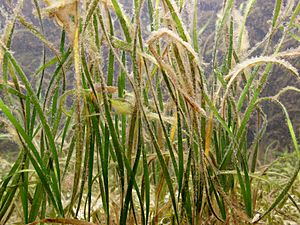Halodule wrightii facts for kids
Quick facts for kids Halodule wrightii |
|
|---|---|
 |
|
| Conservation status | |
| Scientific classification | |
| Genus: |
Halodule
|
| Species: |
wrightii
|
| Synonyms | |
|
|
Halodule wrightii is a special aquatic plant that lives in the ocean. People often call it shoalweed or shoal grass. This plant grows along the coasts of warm oceans around the world. You can find it in places like California, Texas, Florida, Brazil, Australia, and Madagascar.
Sometimes, you might see this plant called Halodule beaudettei. But don't worry, these two names are for the exact same plant species!
Halodule wrightii is a type of herb that grows in salty water. It likes to live in marshes and areas where the ocean meets the land. This means it can be underwater when the tide is high. But when the tide goes out, you might see it sticking out of the water.
This plant has flat leaves that can grow up to 20 centimeters long. They are usually a dark reddish-brown color. The leaves also have a few small teeth along their edges. Its fruits are round or egg-shaped, about 2 millimeters wide.
Seagrasses are like flowering plants that live in the sea. They have special parts like stems, roots, and even flowers. Halodule wrightii often grows in muddy coastal waters. It is also found near many Caribbean islands.
You can also find this seagrass in brackish water along the east coast of the United States. It can grow in waters up to 12 meters deep. Halodule wrightii grows very quickly. It has many shoots that help it get lots of nutrients. Its underground stems, called rhizomes, also help it grow fast. This quick growth helps it adapt to new places.
Contents
How Shoalweed Helps the Ocean
These amazing aquatic plants create large "sea beds" on the ocean floor. They help make the habitat stable by constantly growing new shoots and rhizomes. The long, string-like parts of the seagrass help keep the water clear. They also stop sand or mud from moving around too much.
Seagrass beds are like nurseries for young fish. They give little fish a safe place to hide from bigger predators. These beds also reduce competition among different species. Halodule wrightii also provides food for many fish, small ocean creatures, and even manatees. Because seagrass beds are so important, protecting them is a big deal for the ocean's health. This plant can also live in different levels of saltiness and temperatures. This makes it a very strong and adaptable plant.
The Story of Shoalweed
This plant was named after a person named Charles Wright. He was an American botanist and collector. In the 1850s, Charles Wright went on a trip to explore. That's when he found Halodule wrightii. It is known as a "pioneer species." This means it is one of the first plants to grow in a new or changing area. Halodule wrightii can make new plants in two ways. It can reproduce sexually, which means it flowers. But it can also reproduce without flowers. Flowering is not very common for this plant.
Climate Change and Shoalweed
Our oceans are facing a problem called ocean acidification. This happens when the ocean becomes more acidic because of rising temperatures and more carbon dioxide in the air. This change can harm many sea animals. But Halodule wrightii, as a seagrass, plays a key role in keeping the ocean healthy. It helps move nutrients around and stores carbon.
Scientists did a study in Brazil to see how lower pH levels affect Halodule wrightii. They found that the plant could change and adapt. This shows how tough and flexible this plant is. It can handle big changes in its environment.
Even though it's a strong plant, Halodule wrightii still faces challenges from rising temperatures. When the water gets too warm, it can stop the plant from making its own food through photosynthesis. This can cause the number of these plants to go down.
Helping Shoalweed Grow Again
Human activities have caused many seagrass beds to be damaged. Their populations have also shrunk a lot. One way to help these dying plants is to move seagrass beds from healthy areas to damaged ones. Since Halodule wrightii is a pioneer species, it is often used to help new seabeds grow.
Fun activities like jet skiing and boating can easily damage and pull up seagrass beds. This often happens in shallow coastal waters. Studies have shown that boat anchors can cause a lot of harm to Halodule wrightii levels. This is why it's important to be careful when enjoying the ocean.


